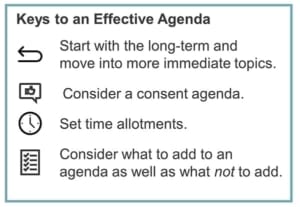October 12, 2020
A Strategic Board Agenda: The Hidden Tool for Effective Governance
Written by: McKinley Advisors
When conversations turn to good governance we often think of sweeping changes to the nominations process, innovative new models, or precisely defined roles and responsibilities. But what if the most overlooked and underutilized tools to improve the effectiveness of your board is more subtle and even mundane?
Enter the board meeting agenda.
In September, I gave a presentation as part of ASAE’s “Troubleshooting Governance Issues” online seminar series. Judging from the conversation and questions from the participants, many association colleagues see the board agenda to be as fraught with challenges as it is teeming with potential. Let’s walk through some tips for developing and, more importantly, adopting a more strategic board agenda.
The purpose of the board agenda
First, what is the purpose of a board of director’s agenda? While there are many possible answers, the core purpose is to provide for structured and intentional discussion and decision making.
Given that the duties of the board span from direction-setting to stewardship of resources to oversight, the agenda provides the CEO or executive director with the ability to guide and focus discussion and decision making. Board members work on what you give them, and if you’re giving them an agenda that is focused primarily on committee report-outs, their time will be spent listening with minimal input. In fact, if you don’t give them anything to work on, they just might work on you.
Good agendas foster good culture
We have all seen the power of board culture—both favorable and detrimental. The Governing Board by Nancy Axelrod defines the characteristics of great boards as:
- Culture of candor, respect, and inquiry
- Appetite for continuous learning and improvement
- The capacity to think and act strategically.
It may seem like a board’s culture has little to do with a meeting agenda, but the agenda actually challenges your leaders to practice and adopt effective behaviors.
The board agenda’s structure and composition
The purpose of the agenda is straight-forward, but how do you make sure you achieve the intended purpose? Here is where structure becomes a crucial consideration.

Think of the agenda as a hierarchy of needs. Board members progress through a series of issues, from the most basic to the most esoteric. While boards have a responsibility to engage in all of these practices, how they engage and to what degree can vary. The agenda’s structure should start with the long-term and then move into more immediate topics. In other words, begin with strategic discussion, move to operational issues, and wrap up with policies and procedures. If you don’t start the board meeting with looking at the horizon, the meeting will be consumed by the tyranny of immediate issues and you’ll never get to that generative discussion about your future.
A consent agenda can help. By grouping regular business items and reports into a single package, board members can approve mundane matters in one motion. This can save hours for more important items. Timed agendas will also save time. Allocate a specific amount of time to each agenda item to bring a more disciplined approach to planning the meeting. This will position your board chair to manage the meeting more effectively as well.
What is on the agenda is as important as what is not on the agenda. An important question to ask: what do I/we hope to achieve with this agenda item? If you don’t have a clear and confident answer, you should eliminate it or save it for another meeting. Likewise, you never want to put anything on the agenda if you don’t already know your desired outcome. Do you want to inform? Gain a decision? Foster generative conversation? Ensure oversight? If you don’t know, you shouldn’t include it.
Building the board agenda
You have a better idea of the why and what of a board agenda, but don’t overlook the important consideration of how you build it. Here are a few of the guiding assumptions and practices I’ve used and recommend to clients:
- Maintain a standard and transparent process for agenda development and be intentional about who has input. This builds trust and fosters those characteristics of great boards.
- Who should have input? You might be shocked to learn that in some associations, the CEO/executive director does not have input. Keep this in mind as you interview for CEO jobs — it’s an important consideration!
- Think strategically about who to involve in the process. Besides the CEO or executive director, the list of those who might offer input is long and should both reflect good governance and the unique aspects of your volunteer leadership culture and governance.
- Once the agenda is set, use it to rehearse for the board meeting with your senior staff and even your board chair. Anticipate challenges and plan responses. This will set everyone up for success during the meeting.
Agendas in a time of crisis, or COVID-19
Most associations follow predictable cycles, and agendas will reflect that in terms of planning and decision-making processes. But what about times of crisis or disruption? This is when you need to simplify the agenda. Resolving tough issues is even tougher online and you need to make sure the most important topics are given sufficient time.
Don’t be afraid to blow up your meeting agenda. If conditions change radically before a board meeting, chances are your board will need to focus on a new set of issues and decisions. Remain nimble and prepare your leaders for it.
This is also a critical time to consider how you communicate with stakeholders beyond your board. Some associations share pre- and post-reports to members that summarize the work of the board. In times of extreme uncertainty and change, it might be important to bring a greater level of transparency to the work of the association. It can foster trust, build loyalty, or even compel members to act.
These tips can apply to any group that works by consensus. Don’t hesitate to use them to foster more impactful governance across your association. Read more about the pace of decision making during a crisis.
Tag(s):
Governance and Leadership
McKinley Advisors
McKinley Advisors is an award-winning association consulting firm dedicated to accelerating associations’ positive impact on the world. McKinley works in partnership with association executives and volunteer leaders to identify and address their most significant challenges and opportunities. McKinley provides services...
Market Research
5 min read
| March 26, 2025
Using Market Research to Drive an Advocacy Agenda
Read More
Governance and Leadership
6 min read
| February 20, 2025
Meeting the Moment: Leading Through Uncertainty
Read More
Strategic Planning
9 min read
| January 28, 2025






